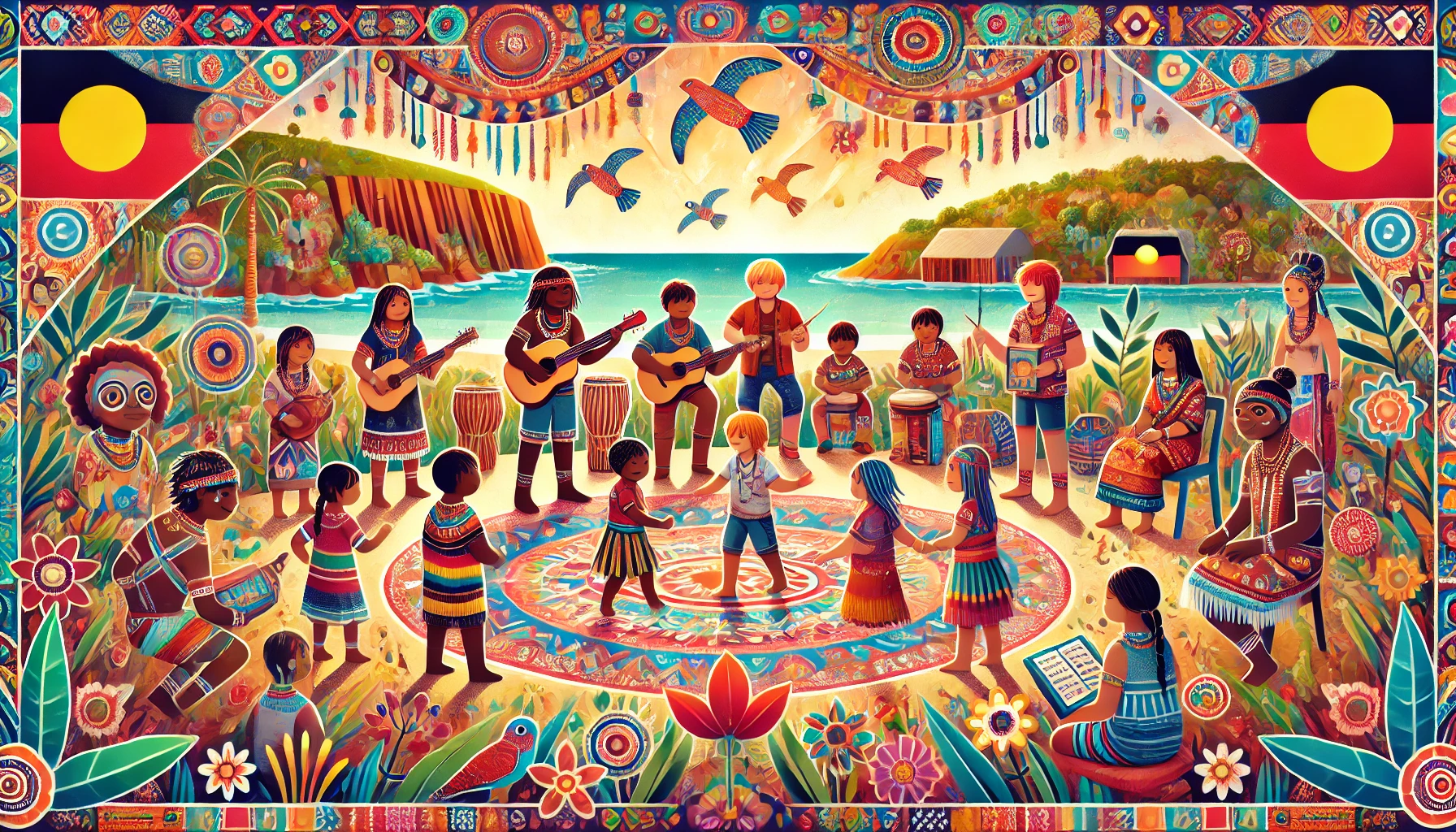
- This event has passed.
National Aboriginal and Torres Strait Islander Children’s Day
August 4

National Aboriginal and Torres Strait Islander Children’s Day is a significant observance in Australia, dedicated to celebrating the strength and culture of Indigenous children. Established in 1988, this annual event falls on August 4th, providing an opportunity to recognize the vital role that community, culture, and family play in the life and development of Aboriginal and Torres Strait Islander children across the nation. It is a day to reflect on the challenges these children face and to celebrate their achievements and potential.
The celebration not only highlights the unique cultural heritage of Indigenous children but also serves as a reminder to all Australians of the ongoing need for society to protect, respect, and nurture the first peoples of this land. It is an essential time for learning about the past and ongoing cultural traditions of Aboriginal and Torres Strait Islander communities, promoting greater understanding and respect among all Australians.
Historical Significance
The history of National Aboriginal and Torres Strait Islander Children’s Day is deeply intertwined with the broader Indigenous rights movement in Australia. The day was first inaugurated by the Secretariat of National Aboriginal and Islander Child Care (SNAICC) as a response to the increasing need for recognition of the cultural identity of Indigenous children and the impact of historical policies such as the Stolen Generations. The date itself was chosen to coincide with the season when Indigenous children in many communities are traditionally weaned, symbolizing their step into a wider world.
This observance has grown in importance and visibility since its inception, serving as a crucial tool for education and awareness. It aims not only to celebrate the individual identities of Indigenous children but also to raise awareness about the disparities in health, education, and opportunities they often face compared to non-Indigenous children. Through this day, efforts are intensified to advocate for the rights and well-being of Indigenous youth, ensuring they have equal opportunities to thrive.
Traditions and Practices
Traditionally, National Aboriginal and Torres Strait Islander Children’s Day involves a range of activities that are deeply rooted in the cultural practices and values of Indigenous communities. These include storytelling sessions, cultural workshops, and community gatherings, where elders share stories of their ancestors and impart knowledge about the land and its history. Such activities are vital for passing down traditions and maintaining the cultural identity of young Indigenous Australians.
Moreover, art plays a significant role in the day’s celebrations. Children participate in painting, crafting, and dance workshops that are reflective of their cultural heritage. These artistic endeavors not only foster a sense of pride and connection to their ancestry but also serve as a bridge for non-Indigenous people to understand and appreciate the rich cultural tapestry of Australia’s first peoples.
Modern Celebrations
In recent years, the celebration of National Aboriginal and Torres Strait Islander Children’s Day has evolved to include more widespread community participation across Australia. Schools, government agencies, and various organizations engage in activities that support the day’s objectives. This includes cultural performances, public talks, and educational programs that are accessible to all Australians. Such events aim to create inclusive spaces where Indigenous and non-Indigenous children can learn from each other and grow together.
Additionally, the use of digital media has expanded the reach and impact of the day. Social media campaigns, online workshops, and virtual reality experiences allow children from remote communities to participate and share their culture with a broader audience. This digital shift not only enhances the visibility of the day but also encourages a nationwide reflection on the collective responsibility to support the rights and well-being of Indigenous children.
10 Congratulations and Wishes
- May you always feel proud of your roots and strong in your cultural identity.
- Wishing you a future filled with opportunities to learn, grow, and succeed.
- Celebrate your heritage, and may your community flourish!
- Wishing you joy as you embrace the traditions of your ancestors.
- May the stories of your elders inspire you to create your own stories of success.
- Here’s to your health, happiness, and the continuing vibrancy of your culture.
- May the strength of your past pave your path to a bright future.
- Let us celebrate your unique role in Australia’s story, today and every day.
- Wishing you a day filled with pride in your culture and hope for tomorrow.
- Celebrate today with joy in your heart and dreams for your future.
10 Unusual Facts
- The date, August 4, was strategically chosen to align with the traditional weaning period of Indigenous children.
- Each year, the day has a different theme to highlight specific aspects of children’s lives and culture.
- It is estimated that there are over 250 Aboriginal and Torres Strait Islander languages, and many children are raised bilingual.
- The logo of the day features artwork that is specifically designed by Indigenous artists.
- In some communities, traditional face painting is done on children, using natural ochres.
- Some of the oldest living cultures celebrated on this day have histories spanning over 60,000 years.
- The day also serves as a platform for addressing the higher rates of disadvantage among Indigenous children.
- Celebrations often include bush tucker feasts, which involve traditional Indigenous Australian foods.
- The day has its own official anthem, sung in both English and Indigenous languages.
- The observance has spread internationally, with events held in countries like New Zealand and Canada to show solidarity.
10 Frequently Asked Questions
- What is the purpose of National Aboriginal and Torres Strait Islander Children’s Day?
- The day is meant to celebrate the strengths and culture of Indigenous children and advocate for their rights and well-being.
- How can non-Indigenous people participate in the celebrations?
- Non-Indigenous people are encouraged to learn about Indigenous cultures, attend events, and show their support through educational and cultural engagement.
- Are there specific colors or symbols associated with the day?
- The day often uses colors significant to Indigenous art and culture, such as earthy reds, yellows, and ochre. The symbols typically reflect elements of nature and Indigenous storytelling.
- How has the day impacted the lives of Indigenous children?
- It has raised awareness of the challenges they face, promoted pride in their heritage, and increased societal efforts to improve their health, education, and opportunities.
- Can organizations contribute to the celebrations?
- Yes, many organizations contribute by hosting events, providing educational resources, and supporting Indigenous communities directly.
- What educational materials are available for schools to use on this day?
- Schools can access a wide range of materials from the SNAICC website, including educational kits, videos, and activity guides.
- Is there a particular focus for each year’s celebration?
- Yes, each year focuses on a different theme that highlights specific challenges or aspects of Indigenous children’s lives.
- How do remote communities participate in the day’s events?
- Remote communities often hold local events and can engage with broader audiences through digital platforms.
- What are some typical activities on this day?
- Activities include storytelling, traditional games, cultural workshops, dance performances, and community gatherings.
- How can someone learn more about this day?
- The official SNAICC website provides comprehensive information, and numerous educational resources are available online.
Conclusion: Why This Day Matters
National Aboriginal and Torres Strait Islander Children’s Day not only celebrates the unique cultures of Indigenous children but also serves as a critical reflection point for addressing the ongoing challenges they face. By focusing on the strength, creativity, and resilience of these young individuals, the day promotes a broader understanding and appreciation of their roles in Australia’s cultural mosaic. It is a day that encourages all Australians to commit to building a more inclusive and equitable society.
From a personal perspective, recognizing and celebrating this day reflects a commitment to learning from our past and supporting a future where every child can succeed. As we celebrate the vibrant cultures and contributions of Indigenous children, we are reminded of the essential role that culture and identity play in the health and happiness of all children.




